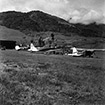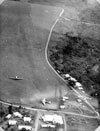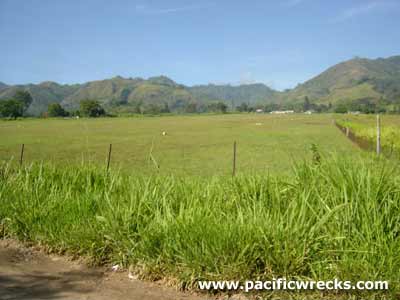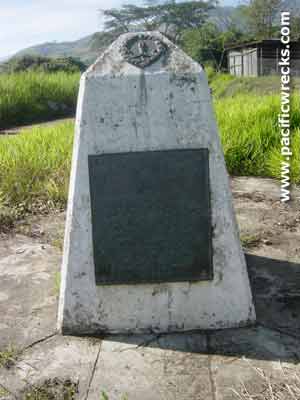|
|
|
|
| Missing In Action (MIA) | Prisoners Of War (POW) | Unexploded Ordnance (UXO) |
| Chronology | Locations | Aircraft | Ships | Submit Info | How You Can Help | Donate |
|
 Guinea Airways April 23, 1931  Guinea Airways 1931  Parer 1931  Stephens c1935-1937  RAAF February 6, 1943  AWM August 8, 1943  Australian Army February 25, 1944  RAAF October 25, 1960 
  Justin Taylan 2003 |
Location Lat 7° 20' 44S Long 146° 43' 7E Wau Airfield is located at an elevation of 3,600' above sea level south of Wau in the interior of New Guinea. Also known as Wau Drome. Prewar and during the Pacific War located in Morobe District in the Territory of New Guinea. Today located in Morobe Province in Papua New Guinea (PNG). Construction During 1927, a single runway was built by Australian Cecil Levien with the assistance of native labors at this location. The runway required aircraft to land uphill at a 5% to 10% grade. On April 19, 1927 a De Havilland DH-37 piloted by Lt. Ernest "Pard" Mustar owned by Guinea Gold took off from Lae Airfield and made the first landing at Wau Airfield. During the late 1920s and 1930s, Wau Airfield was used by a variety of de Havilland, Ford and Junkers aircraft that transported personnel and cargo primarily for gold mining in the area. On August 3, 1940 DH.60M "Eros" VH-UQY ran off the runway during take off and crashed into the during take off and crashed into the government store building, wrecking it and the aircraft. Afterwards, the wreckage of this aircraft was stored at Wau Airfield and was destroyed during the first air raid. Wartime History On January 23, 1942 was the first Japanese air raid against Wau Airfield. The air raid triggers panic among the remaining European residents flee fearing more raids or the arrival of Japanese forces. In early March 1942 Australian Army Captain Allan Cameron and his men withdrew from Salamua via Wau and noted Wau was "a terrible mess after bombing, water on drome, town completely deserted" then walk the Bulldog Track to the south coast. By the middle of 1942 the runway was 1,500 x 100 x 4,000 yards, land uphill, 5-10% grade surfaced with sod, dry, smooth, hard, poorly temporary barricade. Good approach (ENE x WSW), Allied troops, well equipped hospital (doctor) food & water, some servicing (80-90 octane). In early January 1943 the Japanese sent 3,000 troops from Salamaua and Mubo along a winding jungle tracks to caputure Wau and Wau Airfield. In response, the The Victorian 17th Brigade including the 2/5th Battalion, 2/6th Battalion and 2/7th Battalion were flown to Wau Airfield that became the headquarters of the "Kanga Force" that was completely dependent on air supply and reinforcement. On January 30, 1943 at the height of the Japanese advance, enemy fire could the airfield area. This the final Japanese offensive in New Guinea was stopped by the Australians but afterwards they did not have the strength to go on the offensive. Afterwards, Japanese Army Air Force (JAAF) bombers escorted by fighters attacked Wau Airfield. Japanese missions against Wau Airfield February 6, 1943–June 13, 1943 C-47 Skytrain Serial Number 41-38667 Pilot Sams crashed January 18, 1943 CA-9 Wirraway Serial Number A20-447 Destroyed February 6, 1943 at Wau Airfield after a Japanese air raid CA-9 Wirraway Serial Number A20-504 Destroyed February 6, 1943 at Wau Airfield after a Japanese air raid P-38G Lightning Serial Number 43-2195 Pilot Vaught force landed March 5, 1943 P-39 Airacobra Nose Number 4 Pilot Dannacher force landed July 14, 1943 P-39D Airacobra Serial Number 41-38511 Destroyed on the ground at Wau Airfield C-47B Dakota Serial Number A65-92 Pilot Collins crashed October 22, 1960 Today Still in use today as Wau Airport classified as a small airport. Airport codes: ICAO: AYWU IATA: WUG. Until the 1980s there was some wartime aircraft wreckage at the strip, P-39 fuselages and other aircraft parts behind the strip. These relics have since been scrapped or otherwise disappeared. The airport is still in use today, but only by light aircraft. Wau War Memorial A memorial is located at edge of the airfield. The plaque reads: "Wau - Around this airfield and to the south and east in the Wau valley Australian soldiers fought a desperate defensive battle against a Japanese force which advanced from Salamaua through Wanduni." References Notes about New Guinea airfields, recorded circa May - July, 1942 by Oliver C. Doan via Jean Doan / research Edward Rogers Gold Dust and Ashes (1933) pages 200-209 Working in Papua New Guinea 1931-1946 (1983) page 295, 296, 297 The Battle For Wau (2008) pages 1-2 Hell's Battlefield (2012) by Phil Bradley page 25 Contribute
Information Last Updated
|
Map Fallingrain View on Google Earth Photo Archive |
| Discussion Forum | Daily Updates | Reviews | Museums | Interviews & Oral Histories |
|